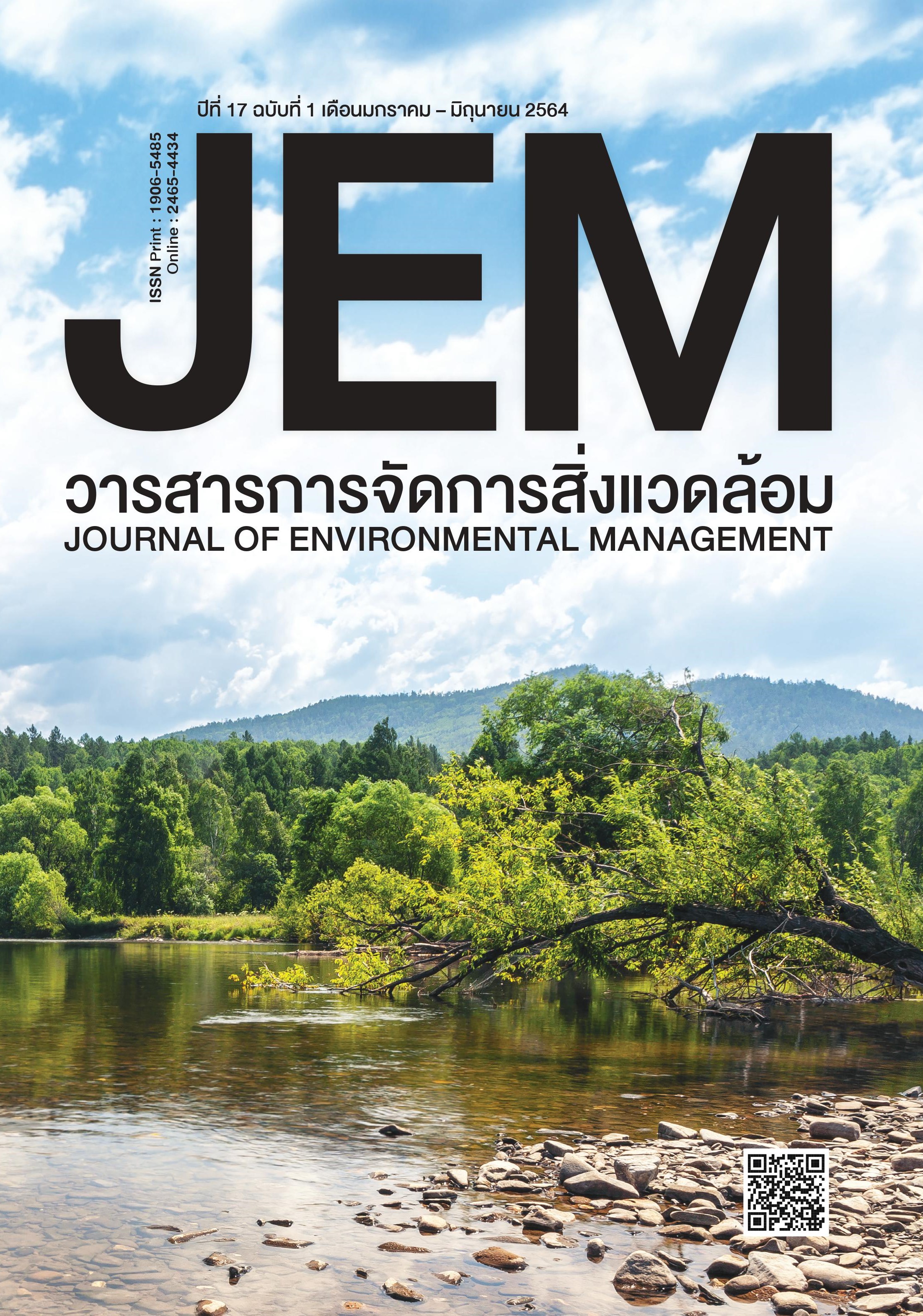การควบคุมการสูบถ่ายน้ำอับเฉาของเรือเดินทะเลเพื่อป้องกันผลกระทบต่อระบบนิเวศชายฝั่งและสิ่งแวดล้อมทางทะเล
DOI:
https://doi.org/10.14456/jem.2021.7คำสำคัญ:
การควบคุม, น้ำอับเฉาเรือ, ความปลอดภัย, สิ่งแวดล้อมทางทะเลบทคัดย่อ
การสูบถ่ายน้ำอับเฉาของเรือเดินทะเลมีความสำคัญต่อการบริหารจัดการความปลอดภัยของเรือ แต่เนื่องจากการปล่อยน้ำดังกล่าวลงสู่ทะเลมีผลกระทบต่อระบบนิเวศชายฝั่งและเป็นภัยคุกคามต่อสิ่งแวดล้อมทางทะเลเป็นอย่างมากเพราะน้ำอับเฉาของเรือมีสิ่งมีชีวิตสายพันธุ์ต่างถิ่นมากมายรวมถึงแบคทีเรีย จุลินทรีย์ และเชื้อโรคต่างๆ ปะปนไปด้วย นำมาซึ่งอันตรายต่อสุขภาพอนามัยของชีวิตมนุษย์และทำให้เกิดการแพร่กระจายของสิ่งมีชีวิตต่างสายพันธุ์ในพื้นที่ต่างๆ ที่เรือเดินทางไปถึงทั่วโลก ส่งผลกระทบขึ้นในระดับภูมิภาคและระดับโลกด้วย องค์การทางทะเลระหว่างประเทศได้เล็งเห็นถึงปัญหาดังกล่าวจึงได้มีการออกกฎข้อบังคับจนพัฒนาขึ้นเป็นอนุสัญญาระหว่างประเทศว่าด้วยการควบคุม และการจัดการน้ำอับเฉาเรือและตะกอน พ.ศ. 2547 เพื่อให้ประเทศที่เป็นภาคีของอนุสัญญาฯ ควบคุมการสูบถ่ายน้ำอับเฉาเรือและใช้เทคโนโลยีในการบำบัดก่อนปล่อยลงสู่ทะเลเพื่อไม่ให้เป็นอันตรายต่อระบบนิเวศวิทยาและสิ่งแวดล้อมทางทะเลอีกต่อไป
เอกสารอ้างอิง
APHA, AWWA and WPCA. (1995). Standard Methods for the Examination of Water and Wastewater.
British Dental Journal (2018). Nature’s own powerful, non-toxic disinfectant. Br Dent J. 224(7), 553.
Carlton JT, Reid Dm and van LeeuwenH. The role of shipping in the introduction of non-indigenous organisms to the coastal waters of the United States and the analysis of control options. National.
Chelossi E and Faimali M. (2006) Comparative assessment of antimicrobial efficacy of new potential biocides for treatment of cooling and ballast waters. SciTotalEnviron. 356(1-3),1-10.
Dang K, Yin P, Sun P and Song Y. (2003). Application study of ballast water treatment by electrolyzing seawater. IMO Proc 2nd Int Bal Wat Tr R&D Symp. P.103 – 111.
Gregg MD and Hallegraeff GM. (2007). Efficacy of three commercially available ballast water biocides against vegetative microalgae, dinoflagellate cysts and bacteria. Harmful Algae. 6(4), 567 – 584.
Hemawong, E. (2019). Ballast Water Treatment: Sustainable maritime transportation. TSA Maritime Directory 2018-2019, 38-39.
Ichikawa S, Wakao Y and Fukuyo Y. (1992). Extermination efficacy of hydrogen peroxide against cysts of red tide toxic dinoflagellates and its adaptability to ballast water of cargo ships. Nip Su Gak. 58(12), 2229–2233.
Jawjit, S, Jawjit, V, Piboon, P, Leamsawang, P and Kanchanapitak, A. (2019). Application of Acidic Electrolyte Water for Disinfection In Water Supply Treatment”. KKU Sci J. 47(3), 520-528.
Jorquera, M.A., G. Valencia, M. Eguchi, M. Katayose and C. Riquelme. (2002). Disinfection of seawater for hatchery aquaculture systems using electrolytic water treatment. Aquaculture. 207(3), 213-224.
Jones AC, Gensemer RW. (2006). Stubblefield WA, van Genderen E, Dethloff GM and Cooper WJ, Toxicity of ozonated seawater to marine organisms. Environ Toxic Chem. 25(10), 2683 – 2691.
Lu, Huaguang, Evaluation of the “Anolyte Water” or “Neutral Electrolyzed Water” Disinfectant Solution on Inactivation of Avaian Influenza Virus and Other Avian Viruses 2020.
Marine department. (2020). The International Convention for the Control and Management of Ships' Ballast Water and Sediments 2004: BWM Convention. P.180-184.
Montani S, Meksumpun L and Ichimi K.(1995). Chemical and physical treatments for destruction of phytoflagellate cysts. J Marine Biotechnol. 2(4), 179–181.
Nakswatdi. (2018). Safety of using Sodium hypochlorite in Ice factories. Department of industrial works.
Oemcke DJ and van Leeuwen J. (2005). Ozonation of the marine dinoflagellate alga Amphidinium sp.–implications for ballast water disinfection. Water Res. 39(20), 5119 – 5125.
Sassi J, Viitasalo S, Rytko ̈ nen J and Leppa ̈ koski E. (2005). Experiments with ultraviolet light, ultrasound and Ozone technologies for onboard ballast water treatment. VTT Tiedotteita- Valtion Teknillinen Tutkimuskeskus. 2313(2313), 1 – 86.
Tsolaki, E., & Diamadopoulos, E. (2010). Technologies for ballast water treatment: a review. Journal of Chemical Technology & Biotechnology. 85(1), 19-32.
Viitasalo S, Sassi J, Rytko nen J and Leppa koski E. (2005). Ozone, ultraviolet light, ultrasound and hydrogen peroxide as ballast water treatments–experiments with mesozooplankton in low-saline brackish water. J Marine Environ Eng. 8(2), 35 – 55.
Xiangpeng K, Yimin Z, Manxia Z, Xuejing S and Wei Z. (2007). Simulated experiment on minimizing the presence chlorella and bacteria in ballast water by combination of micro-hole filtration and UV radiation. J Adv Oxid Technol. 10(1), 186 – 188.



